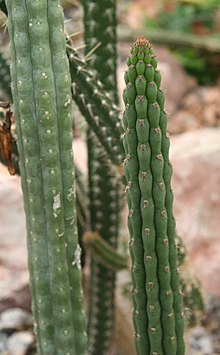| Cleistocactus inquisivensis | |
|---|---|
 | |
| Scientific classification | |
| Kingdom: | Plantae |
| Clade: | Tracheophytes |
| Clade: | Angiosperms |
| Clade: | Eudicots |
| Order: | Caryophyllales |
| Family: | Cactaceae |
| Subfamily: | Cactoideae |
| Tribe: | Cereeae |
| Subtribe: | Trichocereinae |
| Genus: | Cleistocactus |
| Species: | C. inquisivensis |
| Binomial name | |
| Cleistocactus inquisivensis | |
| Synonyms [2] | |
| |
Cleistocactus inquisivensis is a species of cactus. It has been treated as Samaipaticereus inquisivensis and Yungasocereus inquisivensis, before being transferred to Cleistocactus in 2023. [2] [3] When placed in Yungasocereus, it was the only species. [4]
